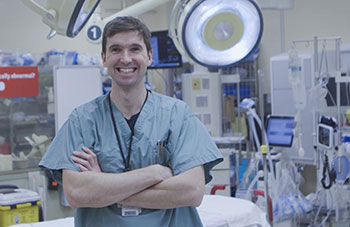“Risk is a spectrum”: Moving forward in our new normal

By Jennifer Stranges

Dr. Andrew Petrosoniak
Three months into the COVID-19 pandemic, the daily count of new cases and deaths are declining, the province is slowly reopening and excitement for summer is palpable.
But are we letting our guard down too soon? Has compliance to public health guidance faded too quickly?
Dr. Andrew Petrosoniak, emergency physician at St. Michael’s and translational simulation lead at Unity Health Toronto, spoke with us about risk perception, the concept of preferred failure, and how to move forward in this new normal.
In a recent Twitter thread, you mentioned the public is experiencing “alarm fatigue” in response to COVID. What does that mean?
Alarm fatigue is basically an alteration in your response to an alarm. When you repeatedly hear the same alarm, you become desensitized to it. Because you’re not paying as much attention to the alarm, its intended impact becomes less effective.
Think of an alarm clock in the morning. If you rely on an alarm each morning and you hit snooze to continue sleeping, it becomes less effective. It’s like background noise.
How is fatigue applicable to the pandemic?
The alarm for COVID – the warnings of transmission and the seriousness of the dangers for our health – rings every day. There is continuous information overload and daily reminders that we should be doing this or avoiding that. It’s resulted in chronic stress. Over time, we’ve become desensitized to the alarms – they’re on the news, in our emails, our social media and our day-to-day routines. As a result, people have stopped responding to the alarm by washing their hands less frequently or standing closer than the recommended six feet, and they perceive the risk to be lower.
Is that perception incorrect?
It’s likely that the actual risk of getting COVID is lower now than it was back in March, but that doesn’t mean that we shouldn’t remain vigilant. This is still very much a reality. Risk is influenced partly by our behavior, our environment and our emotions.
If the warnings of COVID are not as effective now as they were a few months ago, what should change?
There are a few things we can do. First, we should seek to design aspects of our life around this new reality. If the alarms don’t raise cause for concern with us anymore, then we need to create habits or new actions so the behavior we are trying to motivate can happen relatively easily. For example, put hand sanitizer in your car where you’ll be reminded to apply it or have masks accessible in public places in case people forget to bring one with them.
Second, we should be more selective about the alarms so they have more impact. People can’t be on guard all of the time. Preferred failure is the notion of accepting that humans will eventually fail or misstep, but we can guide people towards a preferred failure – a less risky activity. Is the possibility of transmission through groceries risky enough for an alarm to wipe down groceries? Or should that alarm be dedicated to discouraging people from gathering in large groups indoors?
Third, let’s focus on “why.” Evidence supports that people are far more likely to align and comply with what’s being recommended when there’s a common goal and why that’s the goal. A few months ago the goal was clear: to flatten the curve. The goals will shift as the pandemic evolves, but we need to remind people of the rationale behind the decision-making.
What should people know moving forward?
The idea that something is “safe” just because it’s reopening isn’t accurate, it’s artificial. Risk is a spectrum – there are some things that are less risky and others that are more risky.
There continue to be collisions on highways, but we still drive on them. We accept the risk and behave in a way that reduces the risk – like wearing our seatbelts, staying in our lane and following the speed limit.
It’s the same idea with respect to COVID – staying in our house, never leaving, never having anyone over and getting groceries delivered is as close to zero risk as possible, but it’s not realistic. We need to move forward with a harm reduction approach knowing that the risk exists, but our behaviours can limit and minimize our risk.
About St. Michael’s Hospital
St. Michael’s Hospital provides compassionate care to all who enter its doors. The hospital also provides outstanding medical education to future health care professionals in more than 27 academic disciplines. Critical care and trauma, heart disease, neurosurgery, diabetes, cancer care, care of the homeless and global health are among the Hospital’s recognized areas of expertise. Through the Keenan Research Centre and the Li Ka Shing International Healthcare Education Centre, which make up the Li Ka Shing Knowledge Institute, research and education at St. Michael’s Hospital are recognized and make an impact around the world. Founded in 1892, the hospital is fully affiliated with the University of Toronto.
About Unity Health Toronto
Unity Health Toronto, comprised of Providence Healthcare, St. Joseph’s Health Centre and St. Michael’s Hospital, works to advance the health of everyone in our urban communities and beyond. Our health network serves patients, residents and clients across the full spectrum of care, spanning primary care, secondary community care, tertiary and quaternary care services to post-acute through rehabilitation, palliative care and long-term care, while investing in world-class research and education. For more information, visit www.unityhealth.to.
